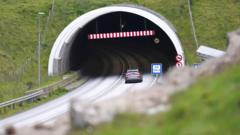China's announcement of the Motuo Hydropower Station in Tibet, touted to surpass the Three Gorges Dam in electricity output, has sparked serious worries among environmentalists and neighboring countries over water security and ecological impact amidst minimal information released by Beijing.
China's Ambitious Hydropower Dam Project Raises Environmental Concerns

China's Ambitious Hydropower Dam Project Raises Environmental Concerns
The Motuo Hydropower Station in Tibet, set to be the largest in the world, is causing alarm among neighboring countries due to opaque plans and potential ecological ramifications.
China is embarking on an ambitious infrastructure project that could reshape the energy landscape in the region and beyond. The Motuo Hydropower Station, to be situated in the remote Medog County of Tibet, is poised to exceed the electricity generation capacity of the Three Gorges Dam, currently the world's largest. While China promotes this project as a pivotal step toward achieving its clean energy goals, the initiative stirs unease among environmentalists and neighboring nations.
The dam will harness the Yarlung Tsangpo River, which eventually flows into India as the Brahmaputra and into Bangladesh as the Jamuna. Given the river’s critical importance for water resources in these countries, concerns are mounting regarding potential impacts on local ecosystems and water security. Additionally, the dam's location is in a seismically active zone, raising alarm about the risks posed by earthquakes.
China officially announced the green light for the Motuo project in late December, yet details remain sparse. Information concerning the project’s financial backing, construction companies involved, and the extent of forced relocations is largely undisclosed. As discussions continue, regional stakeholders call for transparency and dialogue to address environmental implications and the sociopolitical ramifications of such a significant development.



















